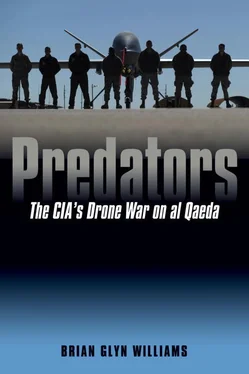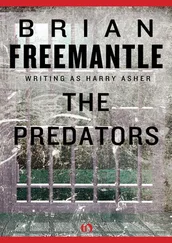Not surprisingly, the Soviets, who were losing up to two thousand men a year to the mujahideen, responded much as the Americans had in Vietnam—by trying to bomb their enemies’ cross-border sanctuaries. According to the Pakistanis, the Soviet air force entered Pakistani airspace more than two thousand times in pursuit of mujahideen, often bombing deep into sovereign Pakistani territory. 1On these bombing raids the Soviet MiG and Sukhoi fighter-bombers used unguided “dumb” bombs, which were extremely imprecise, and this led to the deaths of scores of Pakistani civilians. The Pakistanis responded aggressively to the violations of their airspace and used their new American-supplied F-16 fighter jets to shoot down eight Soviet aircraft. 2(Such robust defense of their airspace contrasts drastically with the Pakistanis’ current policy of allowing the United States to deploy its slow-moving drones against the Taliban in the same region.)
This being the period of the Cold War, the American CIA quickly got involved in the act as well. In the FATA the mujahideen “freedom fighters” were armed by CIA operatives who gave them cash, radios, Blowpipe weapons, and Stinger antiaircraft missiles to fight their Russian adversaries. The CIA worked closely with Pakistan’s Islamist president Mohammad Zia-ul-Haq and his ISI to arm the 200,000 mujahideen so that they could “bleed” the Soviet occupation forces in Afghanistan.
Although it is not true, as many have suggested, that the United States trained and equipped Arab jihad volunteers such as bin Laden, it is true that the United States trained and equipped Hekmatyar and Haqqani. This policy was to later backfire and lead to the so-called blowback effect. Today, Haqqani is the most effective Taliban leader in the eastern Afghanistan provinces of Khost, Paktia, and Paktika, while Hekmatyar is a Taliban-linked insurgent commander in northern Afghanistan. In a case of déjà vu, both of these Pashtun mujahideen-turned-pro-Taliban-insurgents continue to use the FATA as a sanctuary, but this time it is against their former sponsors in the 1980s jihad, the Americans.
They say that war makes strange bedfellows, and this was never more true than with the Americans and President Zia-ul-Haq, a dictatorial, Islamist general who had seized power in Pakistan in 1977 from the democratically elected president of the country, Zulfikar Bhutto (the father of Benazir Bhutto). After the coup, the elder Bhutto was put on trial and executed. When the Soviets were finally driven from Afghanistan in 1989, the Americans began to see the Pakistani leader’s flaws in a clearer light.
Differences between the two anti-Soviet allies were heightened in 1990, when the United States could not confirm that post-Zia Pakistan was not developing a nuclear weapon. The Americans were deeply concerned about the spread of nuclear weapons to this unstable country and enacted the Pressler Amendment to enforce sanctions on Pakistan for trying to develop them. This led Washington to withhold $1.2 billion worth of military equipment that the Pakistanis had already paid for. Among the most important weapons withheld by the Americans was a delivery of F-16 fighter jets. 3
The Pakistanis were of course furious, and the military and ISI felt they were being used by the Americans. At this time Pakistani officers who had been traveling to U.S. military academies ceased coming to America for training. A new generation of Pakistani military officers would come of age in the 1990s distrusting the Americans and believing in Islamist causes such as the jihad against the Indians in the contested province of Kashmir. These same officers would later be asked to join with the Americans in waging war against the Taliban and al Qaeda after 9/11. One Pakistani officer summed up this generation’s views of America when he said, “You used us, and then you dumped us. Pakistanis are convinced you are going to do it again.” 4There was bound to be mistrust between the two allies who had parted ways during the 1990s under a cloud of mutual suspicion.
There were deeper differences between the two nations as well. Pakistan had become an increasingly fundamentalist place under President Zia-ul-Haq, who died in 1989. Zia-ul-Haq had built thousands of madrassas (religious seminaries) to increase Islamic fervor in his country and unite its various peoples under the umbrella of Islamism. Many of these Saudi-funded madrassas were built in the FATA and served as orphanages for young Afghan refugee boys. The students known as Taliban (Taliban is the plural of the Pashto and Persian word for “student”— talib ) who studied in the madrassas in the late 1980s and 1990s were even more conservative than the already conservative Pashtuns.
AFGHANISTAN, 1988–2001
By the early 1990s United States had come to see its former mujahideen proxies as a terrorist threat as well. During the first Gulf War with Iraq, the former CIA-backed Afghan mujahideen leader Gulbuddin Hekmatyar supported Saddam Hussein in his fight against the Americans. 5Then, in 1993, a Pakistani named Ramzi Yousef, who had trained in an Afghan mujahideen camp, tried to blow up the World Trade Center. At this time the United States threatened to designate Pakistan as a state sponsor of terrorism. Additional sanctions were imposed on Pakistan when it bought banned missile technology from Communist China.
In the meantime, post-Soviet Afghanistan had descended into an all-out civil war between the various mujahideen factions. The worst offender in the war was the Pakistanis’ candidate to rule in Kabul, Hekmatyar. He mercilessly shelled the Afghan capital, killing thousands of civilians in his effort to take the city. The siege led to a collapse of authority and to chaos in the Pashtun south. There the ex-mujahideen attacked civilians, set up checkpoints to prey on the common people, and raped women. The southern province of Kandahar in particular was consumed by violence as predatory Pashtun mujahideen bandits made it all but impossible to travel.
The violence in the Afghan south disturbed many Afghan Pashtuns, none more so than a former mujahideen leader–turned–mullah (cleric) named Omar. In 1994 Mullah Omar led a group of religious students in attacking a local mujahideen warlord who had recently attacked a traveling family, killed its men, and turned its women into sex slaves. Mullah Omar’s Taliban overran the warlord’s checkpoint and famously hung him from the barrel of a tank.
When word of Omar’s success spread, his Taliban movement began to snowball. Although there had always been Taliban in the Pashtun tribal areas, the name began to take on a new meaning. It came to mean black-turbaned vigilantes who were fighting to end the chaos and violence of the ex-mujahideen. One by one the Pashtun mujahideen of the south were either killed, disarmed, or grew their beards long and joined the Taliban movement.
By 1995 the Taliban had begun to spread from beyond Kandahar into the western lands of the ethnic Tajiks and into the lands of the northeastern Pashtuns known as the Ghilzais. The most powerful Ghilzai Pashtun mujahideen leader in this area was the previously mentioned Jalaludin Haqqani. Haqqani made the decision to join the Taliban and brought his troops over with him. As a mark of respect, Haqqani was then made Taliban governor of Paktia Province and minister of tribes and frontiers.
By this time the Pakistani ISI had begun to fully bet on the Taliban in their quest to conquer all Afghanistan. There were many reasons for this realpolitik decision. On the one hand, Taliban members were first and foremost Islamists. They did not organize officially on the basis of their Pashtun ethnic identity. This was a huge relief to the Pakistanis who had long feared what would happen if the Pashtuns living in Pakistan and those living in Afghanistan united in an effort to create a larger “Pashtunistan.” This Pashtun state could be created only by slicing land from Pakistan’s northwest and adding it to Afghanistan. The Pakistanis, who had already lost East Pakistan (i.e., Bangladesh), were not going to lose the Pashtuns who made up 15 percent of their state to Afghanistan. 6
Читать дальше












